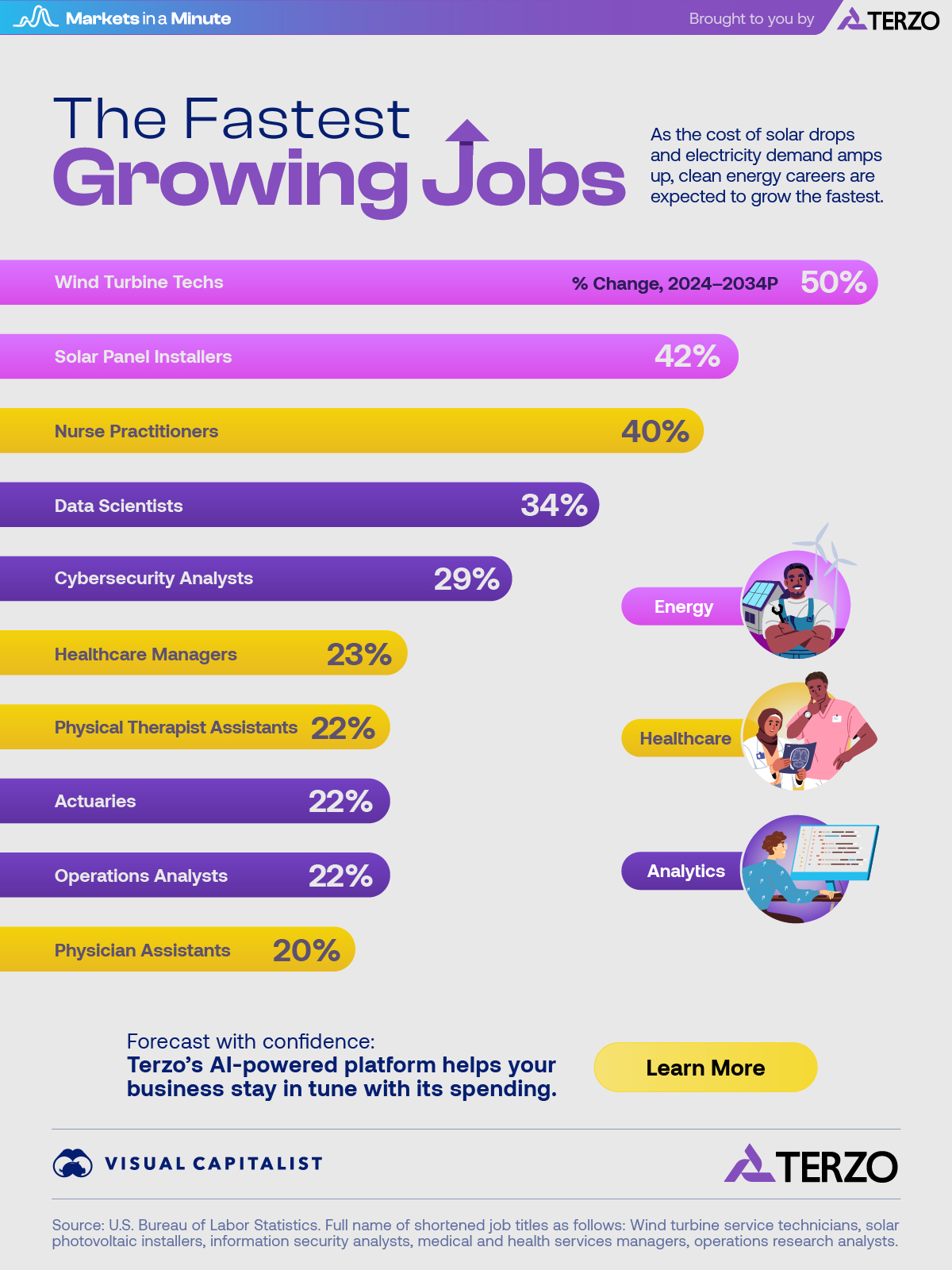
Published
26 minutes ago
on
September 8, 2025
| 15 views
-->
By
Jenna Ross
Graphics & Design
- Zack Aboulazm
The following content is sponsored by Terzo
Ranked: The Fastest Growing Jobs (2024-2034)
Key Takeaways
- The top two fastest growing jobs relate to renewable energy: wind turbine techicians and solar panel installers.
- Four of the top 10 jobs relate to healthcare.
- The remaining four jobs are related to computers and math.
Over the next decade, all jobs in total are expected to grow by 3%. However, economists expect that the fastest growing jobs will grow much more quickly than this.
In this Markets in a Minute graphic, created in partnership with Terzo, we highlight the jobs that experts believe will have the fastest growth rate in the coming years.
A Closer Look at the Fastest Growing Jobs
Using data from the Bureau of Labor Statistics, the jobs below are projected to grow the fastest from 2024 to 2034.
| Job | % Change, 2024–2034P | Median Annual Wage in 2024 |
|---|---|---|
| Wind Turbine Techs | 50% | $62,580 |
| Solar Panel Installers | 42% | $51,860 |
| Nurse Practitioners | 40% | $129,210 |
| Data Scientists | 34% | $112,590 |
| Cybersecurity Analysts | 29% | $124,910 |
| Healthcare Managers | 23% | $117,960 |
| Physical Therapist Assistants | 22% | $65,510 |
| Actuaries | 22% | $125,770 |
| Operations Analysts | 22% | $91,290 |
| Physician Assistants | 20% | $133,260 |
Full name of shortened job titles as follows: Wind turbine service technicians, solar photovoltaic installers, information security analysts, medical and health services managers, operations research analysts.
The Bureau of Labor Statistics expects wind turbine service technicians will see the highest growth. This is because demand for electricity fuels the need for wind turbines to be installed and maintained. Also within the realm of renewable energy, solar panel installers could grow quickly given lower costs and leasing options that eliminate upfront installation expenses.
Both of these roles pay more than the overall median wage of $49,500 in 2024, but less than other jobs on the list.
Growth in Healthcare
Four of the fastest growing jobs are related to healthcare, with this change fueled by the rise of chronic diseases and an aging population. In fact, adults over age 65 make up close to a quarter of the population in some states.
While three of the four medical roles involve the direct care of patients, healthcare managers are responsible for planning, directing, and coordinating health services. Their tasks typically include things like helping develop healthcare goals, ensuring facilities follow regulations, and preparing and monitoring budgets.
Momentum in Math and Computers
The remaining fastest growing jobs are in math and computer-related fields. Of these roles, actuaries have the highest median salary.
As risks and the amount of data increases, actuaries play a key role in helping companies manage their own risk. They may also work at insurance companies to analyze data and project future risks and costs.
Meanwhile, experts predict both data scientists and operations analysts will see strong growth as the amount of data increases and the demand for actionable insights rises.
Data scientists typically collect data, create algorithms and computer models, visualize findings, and make business recommendations. They typically need to be able to write code and develop statistical models, and therefore command a higher salary than operations analysts.

Ready to get actionable insights from your company’s data? Explore Terzo’s AI-powered financial platform for a full view of your spending.
More from Terzo
-

Investor Education2 weeks ago
The $127 Trillion Global Stock Market in One Giant Chart
This graphic pieces together the $127T global stock market to reveal which countries and regions dominate—and how much equity they control.
-

Personal Finance3 weeks ago
Late to the Ladder: The Rise in First-Time Home Buyers’ Age
The median age of first-time home buyers has reached a historic high. See just how long it’s taking people to get on the property ladder.
-

Markets1 month ago
Unpacking Real Estate Ownership by Generation (1991 vs. 2025)
The Silent Generation’s share of real estate has dropped dramatically as people age, but how have Baby Boomers, Gen X, and Millennials fared?
-

Business1 month ago
America’s Economic Engines: The Biggest Industry in Every State
Real estate is the biggest industry by GDP in 26 states. Find out why it dominates—and what fuels the rest of the country.
-

Maps2 months ago
Mapped: Manufacturing as a Share of GDP, by U.S. State
Tariffs are rising to boost American-made goods. Which states gain the most—and least—from manufacturing today?
-

Technology2 months ago
Profit Powerhouses: Ranking The Top 10 U.S. Companies by Net Income
Collectively, the ten most profitable U.S. companies have a net income of $684 billion—more than the entire GDP of Belgium.
-

Money3 months ago
Millionaire Hubs: Mapping the World’s Wealthiest Cities
New York City has the highest millionaire population globally. Which other cities attract the world’s wealthiest?
-

Economy3 months ago
Tomorrow’s Growth: GDP Projections in Key Economies
The global economy is expected to have slighter slower growth going forward. Which countries are on track to have the biggest GDP increases?
-

Money4 months ago
Mapped: Interest Rates by Country in 2025
The U.S. has kept their target rate the same at 4.25-4.50%. What do interest rates look like in other countries amid economic uncertainty?
-

Markets5 months ago
U.S. Housing Prices: Which States Are Booming or Cooling?
The national housing market saw a 4.5% rise in house prices. This graphic reveals which states had high price growth, and which didn’t.
-

Investor Education5 months ago
The Silent Thief: How Inflation Erodes Investment Gains
If you held a $1,000 investment from 1975-2024, this chart shows how the inflation rate can drastically reduce the value of your money.
-

Politics6 months ago
Trade Tug of War: America’s Largest Trade Deficits
Trump cites trade deficits—the U.S. importing more than it exports—as one reason for tariffs. Which countries represent the largest deficits?
Subscribe
Please enable JavaScript in your browser to complete this form.Join the 375,000+ subscribers who receive our daily email *Sign Up